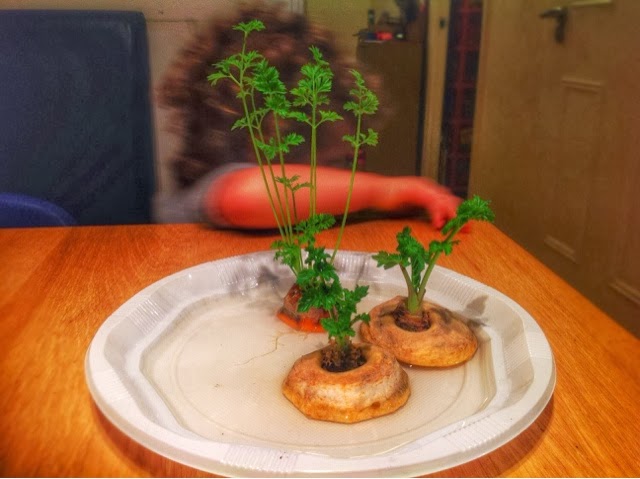With the promise of Spring on the way I have been growing some carrot tops and Parsnip tops with Harmonie and Honi to get us in the mood!
It is a very simple and easy way show children how basic cloning works.
Plants can be cloned artificially using tissue culture. In short this is how cloning from tissue culture works:
- Small amounts a plant's tissues or cells is extracted.
- The tissues or cells used contain the plants DNA. It is then put on a culture medium, usually a sterile gel that contains all the nutrients required for growth to take place.
- The process of mitosis takes place. Mitosis is when the cells begin to duplicate, they do this more and more until they begin to look like a plant!
- When the cells have reached this point then they can be moved to a pot and develop into a fully grown plant.
We too can clone plants at home without having to extract any cells simply by using cuttings much like with the carrot and Turnip tops...
Cuttings are the simplest way to clone a plant. I did it with a sage plant from my old garden, I cut off a couple of branches and stuck them into some earth. Gardeners call this striking! Sometimes plant hormones are used to speed up growth in plants. It is also best to cover the cutting in a clear plastic bag to keep it moist and warm for a few weeks which is when new roots will develop and a new plant is made!
If you want to try striking a plant basil is quite easy to do. You just need to leave the cut end in some water and wait for the roots to develop before placing in a soil filled pot!
Vegetable tops make this a more visual process for children!
HOW TO CLONE A CARROT IN TWO STEPS:
STEP ONE
Cut off the top of a carrot
STEP TWO
place it in a pot of water where there is plenty of sunlight.
You will soon find the bit at the top that appears to be dead will come to life and sprout a beautiful plant.
It won't make another carrot doing this way but the carrot tops are edible!
Other plants that this can be done with that I know of are:
- Beet
- Radish
- Turnip
- Parsnip
- Pineapple
If you cut the bottoms off instead and place the roots in water you can grow... - Celery
- Romaine lettuce
- Leeks
- Lemon Grass placed in water will grow roots in about three weeks and then grow more lemon grass.
Also...
You can grow more ginger by sticking the ginger root straight into the ground, it is a root so it will grow with patience watering and sunlight.
You can grow more ginger by sticking the ginger root straight into the ground, it is a root so it will grow with patience watering and sunlight.
You can grow potatoes and sweet potatoes from an old potato. Cut of any eyes or buds, wait for a few weeks for the roots to shoot and then stick them in some earth. A separate plant will grow for each eye planted.
Potato are tubers, the bit of the potato plant, tubers are able to grow new roots and shoots forming another identical plant.
Advantages to cloning plants:
- Cloning allows the grower to mass produce plants that can be difficult to grow from seed.
- All the plants are genetically identical, so you can be sure of their characteristics. For example if you clone a pink rose bush you can be sure that all the roses will be the same pink.
Disadvantages to cloning plants:
- lack of genetic variation can mean that the plants are more susceptible to disease or changes in environmental conditions
- If the clones are affected with disease, all will be affected not just a few!
Key words:
Cuttings
Cloning
Asexual reproduction
Mitosis
Cells
DNA


No comments:
Post a Comment